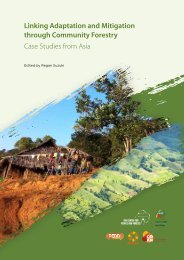Desktop Study on - Regional Climate Change Adaptation ...
Desktop Study on - Regional Climate Change Adaptation ...
Desktop Study on - Regional Climate Change Adaptation ...
Create successful ePaper yourself
Turn your PDF publications into a flip-book with our unique Google optimized e-Paper software.
Assessment of Capacity Gaps and Needs of South East Asia Countries<br />
in Addressing Impacts, Vulnerability and Adaptati<strong>on</strong> to <strong>Climate</strong> Variability and <strong>Climate</strong> <strong>Change</strong><br />
Center (NAFReC) (NAFRI, 2008b) reviewed the<br />
instituti<strong>on</strong>al resp<strong>on</strong>ses in the agricultural sector.<br />
Impacts <strong>on</strong> Agriculture and Food<br />
Security Sector<br />
Snidv<strong>on</strong>gs’ (2006) has undertaken a study <strong>on</strong><br />
climate change impacts due to extreme hydrological<br />
events and changes in water resources, including<br />
crop modelling for assessing the impact of climate<br />
change <strong>on</strong> rice productivity in Southeast Asia. <str<strong>on</strong>g>Study</str<strong>on</strong>g><br />
findings indicate that the rain-fed rice producti<strong>on</strong> in<br />
Lao PDR, more specifically in Savannakhet province<br />
– shows tendency to be <strong>on</strong>ly slightly reduced under<br />
the modelled climate change scenario, taking into<br />
account l<strong>on</strong>ger hot and shorter cold periods (see<br />
also chapter 2.1.3 and Figure 4). However, it is to be<br />
noted that potential impacts due to more frequent<br />
and intense floods have not been assessed in this<br />
study. Indeed, discussi<strong>on</strong>s with farmer communities<br />
in Lao PDR have shown c<strong>on</strong>cerns am<strong>on</strong>g the farmers<br />
in view of an increased possibility of floods in future<br />
due to climate change (Chinvanno et al., 2006).<br />
Already, climate variability has been affecting Lao<br />
farmers, due to which adopting adaptati<strong>on</strong> measures<br />
is necessary. The adaptati<strong>on</strong> measures have evolved<br />
over the years, mainly because of the increasing<br />
variability in the dates of <strong>on</strong>set and end of the rainy<br />
seas<strong>on</strong>, changes in the wind directi<strong>on</strong>, changes in<br />
rainfall distributi<strong>on</strong> pattern throughout the seas<strong>on</strong>,<br />
and an increase in thunderstorm activity. Further,<br />
occurrence of these climatic events have increased<br />
in frequency throughout the rainy seas<strong>on</strong>, namely<br />
midseas<strong>on</strong> dry spell after that rice seeds are sowed<br />
and occurrence of floods before the crop has been<br />
harvested have posed significant threats to farmers’<br />
livelihoods (Chinvanno et al., 2006).<br />
Vulnerability and Adaptati<strong>on</strong> in the<br />
Agriculture and Food Security Sector<br />
Vulnerability<br />
The country has seen a significant reducti<strong>on</strong> of<br />
poverty due to the ec<strong>on</strong>omic growth during the past<br />
two decades and despite the fact that the agriculture<br />
sector is the populati<strong>on</strong>’s predominant ec<strong>on</strong>omic<br />
activity, insufficient food security is still affecting an<br />
important part of the Lao populati<strong>on</strong> (WFP, 2007).<br />
One main reas<strong>on</strong> is that the country is predominantly<br />
mountainous – about 80% of the total surface (Lao<br />
PDR, 2009a) – making significant porti<strong>on</strong>s of the<br />
land not accessible by road and/or not cultivable<br />
(WFP, 2007). Especially in rural areas, chr<strong>on</strong>ic<br />
malnutriti<strong>on</strong> is alarmingly high, with 50% of the<br />
children being affected. This indicates that Lao’s food<br />
security has not improved over the past decade. The<br />
study highlights that 13% of Lao’s rural populati<strong>on</strong><br />
faced food insecurity at the time of the studied<br />
period during the post-harvest seas<strong>on</strong> and more<br />
than 50% were at risks to becoming food insecure<br />
because of floods and droughts (internal shocks) or<br />
oil price peaks (external shocks). This means that in<br />
total, two thirds of the rural populati<strong>on</strong> is effectively<br />
or potentially affected by food insufficiency. The<br />
study identified droughts as the biggest threat to<br />
the food insecurity, potentially affecting 46% of the<br />
rural populati<strong>on</strong>.<br />
Adaptati<strong>on</strong><br />
Farm households in Savannakhet Province have<br />
developed c<strong>on</strong>siderable ability to adapt to existing<br />
climate variability and hazards, states Snidv<strong>on</strong>gs<br />
(2006) and the working report of Chinvanno et<br />
al. (2006). Chinvanno et al. (2006) and Snidv<strong>on</strong>gs<br />
(2006) assessed the vulnerability and the adaptati<strong>on</strong><br />
of farmers to climate change. The results of the<br />
field survey indicate that the farmers’ vulnerability<br />
varies from place to place, depending <strong>on</strong> the degree<br />
of climate impact, socio-ec<strong>on</strong>omic as well as the<br />
area’s physical c<strong>on</strong>diti<strong>on</strong>s. At the same time, the<br />
socio-ec<strong>on</strong>omic situati<strong>on</strong> str<strong>on</strong>gly influences the<br />
adaptati<strong>on</strong> measures undertaken by the rain-fed<br />
farmers. Farmers in less developed socio-ec<strong>on</strong>omic<br />
c<strong>on</strong>diti<strong>on</strong>s in Lao PDR tend to rely mostly <strong>on</strong> simple<br />
farm level measures being implemented with limited<br />
financial and other resources, the food security<br />
of the household being a major focus. Adopted<br />
farm level measures include raising livestock<br />
and harvesting for increased food resources and<br />
changes in seed varieties, timing and methods of<br />
cultivati<strong>on</strong>. Farmers in Lao PDR tend to rely <strong>on</strong> the<br />
natural eco-system for improving their livelihood.<br />
Farmers in more developed c<strong>on</strong>diti<strong>on</strong>s such as in<br />
Thailand, <strong>on</strong> the other hand, show the tendency<br />
to adopt measures such as seas<strong>on</strong>al migrati<strong>on</strong> to<br />
urban areas for diversifying the income and show<br />
a higher dependency <strong>on</strong> improved technologies<br />
and financial resources. Due to the limited extent<br />
of adaptati<strong>on</strong> measures at nati<strong>on</strong>al and community<br />
levels to date, the study identifies the adaptive<br />
capacity at the individual farm levels as key limiting<br />
factor for managing climate risks in Lao PDR. The<br />
implementati<strong>on</strong> of an early warning system together<br />
with accurate risk communicati<strong>on</strong> techniques<br />
reaching the affected populati<strong>on</strong> could improve the<br />
performance of <strong>on</strong>-farm adaptati<strong>on</strong> measures, but<br />
c<strong>on</strong>straints include the precisi<strong>on</strong> of climate forecasts<br />
and the reliability of communicati<strong>on</strong> networks.<br />
Also, the lack of suitable seed types, dependency <strong>on</strong><br />
rice, c<strong>on</strong>sumpti<strong>on</strong> preferences and lack of financial<br />
knowledge and other resources impose limits to<br />
21

















